
Beaufortia sparsa, commonly known as the swamp bottlebrush, is a plant in the myrtle family, Myrtaceae and is endemic to the south-west of Western Australia. It is an erect or spreading shrub with round, dished leaves crowded on the younger stems, and bright red flower spikes in the warmer months.

Eremaea pauciflora is a plant in the myrtle family, Myrtaceae and is endemic to the south-west of Western Australia. It is a shrub with small leaves and orange flowers at the ends of its branches. It has the most widespread distribution of the eremaeas with considerable variation in its characteristics so that three varieties are recognised. It was the first Eremaea to be described formally but was not originally given the name Eremaea.

Eremaea fimbriata is a plant in the myrtle family, Myrtaceae and is endemic to the south-west of Western Australia. It is a small shrub with small leaves and single purple flowers on the ends of the branches. The fruits are woody, urn-shaped with a small opening at the top. Unlike other eremaeas which remain dormant during winter, Eremaea fimbriata begins the new year's growth in July or August.
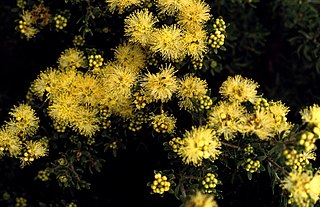
Melaleuca leiopyxis is a shrub in the myrtle family, Myrtaceae and is endemic to an area near the west coast of Western Australia. It has bright yellow flowers and is very similar to Melaleuca depressa. The ranges of the two species overlap making it difficult to distinguish between them.
Calothamnus glaber is a plant in the myrtle family, Myrtaceae and is endemic to near-coastal areas in the south-west of Western Australia. It is a shrub, similar to Calothamnus blepharospermus but its leaves are slightly longer and narrower and the parts of its flowers are glabrous.

Calothamnus pachystachyus is a plant in the myrtle family, Myrtaceae and is endemic to the south-west of Western Australia. It is an erect, much-branched shrub with thick bark, flat leaves and clusters of red flowers in spring.

Eremaea acutifolia, commonly known as rusty eremaea is a plant in the myrtle family, Myrtaceae and is endemic to the south-west of Western Australia. It is a small shrub with needle-like leaves and which bears orange-coloured flowers on short side branches and fruits with a surface that is rough to the touch.
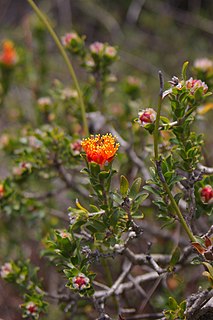
Eremaea asterocarpa is a plant in the myrtle family, Myrtaceae and is endemic to the south-west of Western Australia. It is a shrub with broad, flat leaves, and orange-coloured flowers in late winter or spring. Single flowers appear on the ends of branches formed the previous year.
Eremaea atala is a plant in the myrtle family, Myrtaceae and is endemic to the south-west of Western Australia. It is a small shrub with small, soft, non-prickly leaves, and purple flowers in late spring or summer. Flowers appear in groups of up to five usually on the ends of branches formed in the same year's growth.
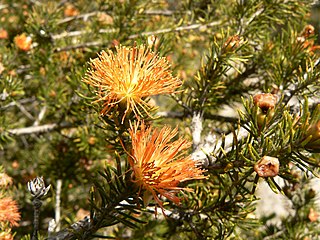
Eremaea blackwelliana is a plant in the myrtle family, Myrtaceae and is endemic to the south-west of Western Australia. It is a shrub with soft, pointed, non-prickly leaves, orange flowers in spring and cup shaped to almost spherical woody fruits. Flowers appear singly on the ends of short side branches formed in the previous year.

Eremaea brevifolia is a plant in the myrtle family, Myrtaceae and is endemic to the south-west of Western Australia. It is an erect, compact to spreading shrub with small, crowded leaves and orange-coloured flowers in early spring, followed by fruits with a rough outer surface.
Eremaea × codonocarpa is a plant in the myrtle family, Myrtaceae and is endemic to the south-west of Western Australia. It is thought to be a stabilised hybrid between two subspecies of Eremaea. It is a small shrub with triangular leaves and flowers a shade of pink to purple on the ends of the branches.
Eremaea dendroidea is a plant in the myrtle family, Myrtaceae and is endemic to the south-west of Western Australia. It is a small tree with small leaves and orange-coloured flowers on the ends of the branches in September. It has the most northerly distribution of all the eremaeas.
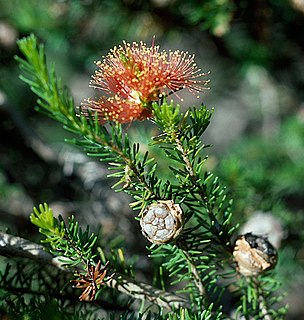
Eremaea ebracteata is a plant in the myrtle family, Myrtaceae and is endemic to the south-west of Western Australia. It is a shrub with narrow, mostly linear leaves and which bears orange-coloured flowers on the long branches of the same season's growth. The fruits have a surface that is rough and lumpy.

Eremaea ectadioclada is a plant in the myrtle family, Myrtaceae and is endemic to the south-west of Western Australia. It is a low, spreading shrub with small leaves, and orange-coloured flowers on the ends of the long branches which grew in the previous year.
Eremaea hadra is a plant in the myrtle family, Myrtaceae and is endemic to the south-west of Western Australia. It is a shrub with thin, flat and very prickly leaves. It has violet-coloured flowers on the ends of its branches in late spring followed by smooth, cup-shaped fruits.
Eremaea × phoenicea is a plant in the myrtle family, Myrtaceae and is endemic to the south-west of Western Australia. It is thought to be a stabilised hybrid between two subspecies of Eremaea. It is an erect to spreading shrub with pointed, elliptic leaves and small groups of flowers, a shade of pink to red, on the ends of the branches.
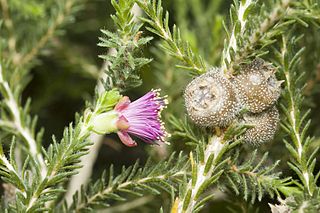
Eremaea purpurea is a plant in the myrtle family, Myrtaceae and is endemic to the south-west of Western Australia. It is a shrub with erect branches, small leaves and purple flowers in pairs on the ends of the branches. The fruits are woody, cup-shaped capsules which release their seeds when dry.

Eremaea violacea is a plant in the myrtle family, Myrtaceae and is endemic to the south-west of Western Australia. It is low, spreading shrub with narrow, prickly leaves and which bears violet-coloured flowers on short side branches.
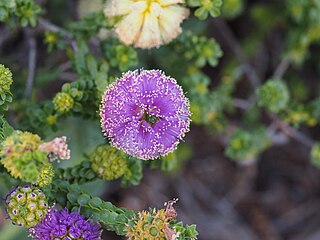
Phymatocarpus porphyrocephalus is a plant in the myrtle family, Myrtaceae and is endemic to the south-west of Western Australia. It resembles many small species of Melaleuca, mainly differing in the way its anthers are attached at the top of the stamens. In Phymatocarpus they are attached at their base and open at the other end through two slits. It is a shrub with many small heads of pink to purple flowers fading to white, often covering the plant for several weeks in spring.














